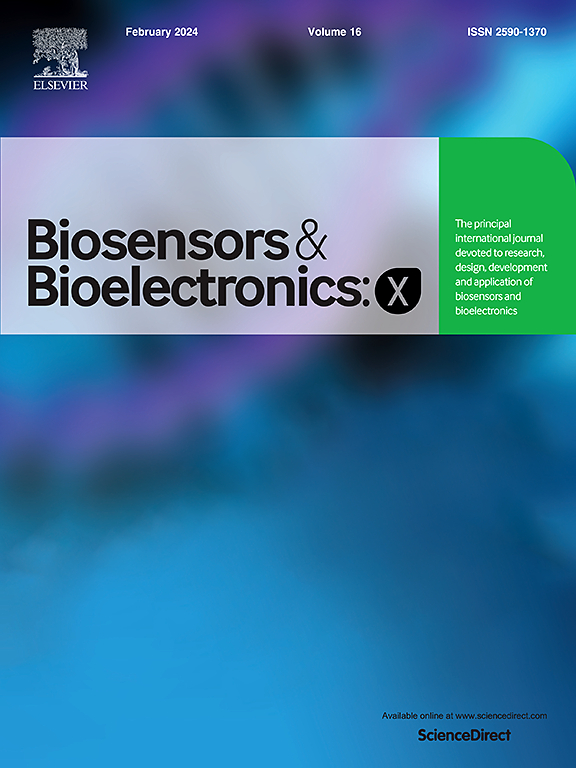用于未来诊断的WGM传感器:从小分子到整个生物体
IF 10.61
Q3 Biochemistry, Genetics and Molecular Biology
引用次数: 0
摘要
在一个不断面临疾病和病原体挑战的世界,快速诊断至关重要。窃窃廊模式(WGM)谐振器提供了一种先进的传感器技术,适用于各种分析物的检测。与表面等离子体共振(SPR)一样,它们提供了高度敏感和选择性的测量,是医学诊断的理想选择。然而,传统的WGM谐振器固定在光学耦合器附近的表面上,使其生产复杂且成本高昂。然而,最近的一种方法是将聚苯乙烯微球定位在流控芯片的空腔中作为谐振器,简化了制备和功能化,并显示出增强的性能。在这里,我们评估了这些传感器对不同分析物大小的适用性,从小分子(<1000 Da)到整个生物体。通过采用不同的检测策略,我们证实了WGM传感器对广泛目标检测的适用性。本研究以嗜肺乳杆菌、TEM-1 β -内酰胺酶、氨曲南和美罗培南为代表。我们表明,检测是成功的所有选定的分析物,而小分子需要额外的信号放大通过三明治的方法。分析结果显示,LOD为0.09 μM, LOQ为0.28 μM, R2 > 0.99。此外,对比测量表明,WGM比广泛使用的金标准SPR (LOD 0.34 μM;Loq为1.12 μm)。综上所述,我们的工作证明了WGM传感器在病原体检测、蛋白质定量或小分子分析方面的适用性,与目前的金标准方法相比,其灵敏度有所提高。本文章由计算机程序翻译,如有差异,请以英文原文为准。
WGM Sensors for future diagnostics: small molecules to whole organisms
In a world facing constant challenges from diseases and pathogens, rapid diagnosis is crucial. Whispering gallery mode (WGM) resonators present an advanced sensor technology suitable for the detection of various analytes. Like surface plasmon resonance (SPR), they offer highly sensitive and selective measurements, ideal for medical diagnostics. Traditional WGM resonators, however, are immobilized on surfaces near optical couplers, making their production complex and costly. Nevertheless, a more recent approach employs polystyrene microspheres localized to cavities in fluidic chips as resonators, simplifying preparation and functionalization and displaying enhanced performance. Here, we assess the applicability of those sensors to different analyte sizes, ranging from small molecules (<1000 Da) to whole organisms. By employing different detection strategies, we confirm the applicability of the WGM sensors for detecting a wide range of targets.
The study focuses on L. pneumophila, TEM-1 beta-lactamase, aztreonam, and meropenem as representatives of these three major groups. We show that the detection was successful for all chosen analytes, while small molecules required additional signal amplification through a sandwich approach. Results of the analysis of the protein measurements showed an LOD of 0.09 μM and an LOQ of 0.28 μM with a R2 greater than 0.99. Additionally, a comparative measurement demonstrates that the WGM is more sensitive than the widely used gold standard SPR (LOD 0.34 μM; LOQ 1.12 μM). Taken together, our work demonstrates the applicability of the WGM sensors to pathogen detection, protein quantification or small molecule analysis with an improved sensitivity compared to current gold standard methods.
求助全文
通过发布文献求助,成功后即可免费获取论文全文。
去求助
来源期刊

Biosensors and Bioelectronics: X
Biochemistry, Genetics and Molecular Biology-Biophysics
CiteScore
4.60
自引率
0.00%
发文量
166
审稿时长
54 days
期刊介绍:
Biosensors and Bioelectronics: X, an open-access companion journal of Biosensors and Bioelectronics, boasts a 2020 Impact Factor of 10.61 (Journal Citation Reports, Clarivate Analytics 2021). Offering authors the opportunity to share their innovative work freely and globally, Biosensors and Bioelectronics: X aims to be a timely and permanent source of information. The journal publishes original research papers, review articles, communications, editorial highlights, perspectives, opinions, and commentaries at the intersection of technological advancements and high-impact applications. Manuscripts submitted to Biosensors and Bioelectronics: X are assessed based on originality and innovation in technology development or applications, aligning with the journal's goal to cater to a broad audience interested in this dynamic field.
 求助内容:
求助内容: 应助结果提醒方式:
应助结果提醒方式:


